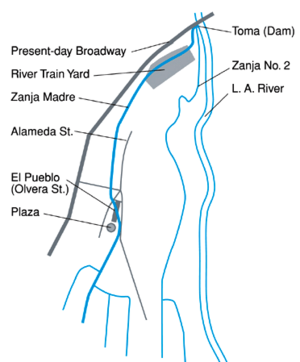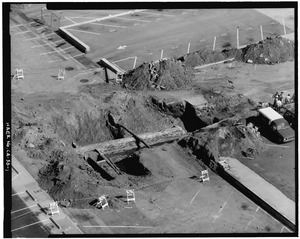Zanja Madre facts for kids

The Zanja Madre (which means "Mother Trench" in Spanish) was the very first water system for the city of Los Angeles. It was an aqueduct that brought water from the Los Angeles River to the early settlement, known as the Pueblo de Los Angeles.
This important water system was an open, earthen ditch, or zanja, built by the community's first settlers. It was finished within a month of the pueblo being founded! The Zanja Madre provided water for people's homes and for watering crops in the fields. This steady supply of water was absolutely vital for the community to survive and grow. Over time, the main Zanja Madre fed eight smaller ditches. While parts of the system were improved with brick pipes after 1884, it eventually couldn't keep up with the growing population and farming needs. By 1904, the Zanja Madre was mostly replaced, though some parts were still used for storm water. A person called a Zanjero was in charge of maintaining it.
Contents
How Los Angeles Got Its First Water
The Pueblo de Los Angeles was a new town officially started by Spain. Spain created different types of settlements in Alta California, including military forts (presidios), religious missions, and civil towns (pueblos). These pueblos were meant to provide food and goods for the military, so they needed to be able to grow crops.
Governor Felipe de Neve carefully planned the new settlement. His plans included a clear instruction to provide water for the town. He wanted to make sure the water could reach as much farmland as possible. The pueblo itself was built on slightly higher ground, so the water source had to be even higher to flow down to the fields.
The Zanja Madre began near what is now Broadway, close to the Elysian Hills and the Los Angeles River. A simple dam, called a toma, made of earth and brush, was built to collect water from the river. This water then flowed into the ditch, which ran along a raised path down to the pueblo. Once in town, the water split into many smaller ditches to reach different areas. In the 1850s, a large water wheel was built to lift water into the Zanja Madre and then into a main brick reservoir. This reservoir was located where the Plaza is today, at the end of Olvera Street. Floods often damaged the water wheel and the toma, which had to be rebuilt several times.
Upgrading the Water System
The original Zanja Madre, being an open ditch, had problems. Its soft, sandy tunnels sometimes collapsed. People tried to fix these issues by lining the ditches with brick. However, a big flood in 1884 washed away the wooden dam, and the entire aqueduct system was temporarily abandoned. Even before this, by 1878, people knew that the Zanja system needed major improvements. They planned to replace smaller ditches with pipes and use concrete for larger areas. After the 1884 flood, the simple earthen dam and open ditch were put back into use while bigger plans were made.
In 1888, the city planned to install pipes in most of the existing zanjas, but they didn't have enough money to finish all the work. The main tunnel at the start of the Zanja Madre was rebuilt, and much of the water channel was lined with brick or concrete. By 1893, Los Angeles had about 50 miles (80 km) of zanjas within the city and another 40 miles (64 km) outside its limits. Over the years, parts of the Zanja Madre were moved many times, especially as railroads were built. Eventually, as the city developed newer and more advanced water systems, much of the old Zanja Madre was removed.
Discovering the Old Waterways Today
Even though the Zanja Madre system was mostly replaced, parts of it are still found today! At least 18 different sections of the Los Angeles Zanja system have been discovered during construction projects over the years. Archaeologists first officially recorded a piece of the Zanja Madre in 1978 during the building of the Plaza de Dolores.
In 2000, two people found a section of the Zanja near a parking garage, which was reported in local newspapers. Later, archaeologists working on the MTA Gold Line train project studied uncovered brick pipes. They expected to find more sections near the train yard, but didn't, as it was thought that railroad construction had destroyed them.
Then, in 2005, MTA construction crews unexpectedly found more sections of the brick Zanja Madre. Archaeologists were called in to examine these finds, which were mostly red-brick aqueducts about the size of a penstock (a pipe that carries water). Now, serious studies are underway to document these routes and have the Zanja Madre added to historical registers, protecting its legacy.
In 2014, during digging for a new building project called Blossom Plaza, a 100-foot (30 m) long section of the Zanja Madre was discovered. However, a 40-foot (12 m) part of this section was quickly removed and destroyed to allow construction to continue. This decision was criticized by local news outlets.
Today, at least three parts of the Zanja Madre can still be seen on public land. One section is owned by Los Angeles County, next to the Gold Line tracks near Los Angeles State Historic Park. Two other sections are located inside buildings at the Pueblo de Los Angeles Historical Monument. A hand-drawn map from 1887 city records helped identify where some of these newly found brick and mortar pipes were located.
Images for kids
-
1873 map of the Plaza, including course of Zanja Madre
See also






